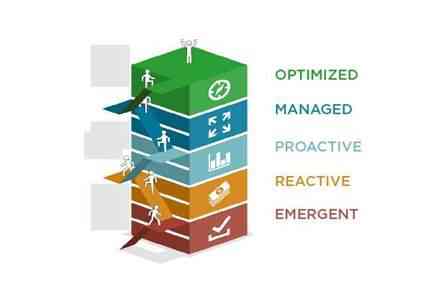 IT Governance Assessment
IT Governance Assessment



For each question, choose the answer that you feel best describes your current business environment.
For each question, choose the answer that you feel best describes your current business environment.
Low maturity organizations buy products ad-hoc as needed and based on affordability/availability without consistency. As maturity increases approved technology is aligned to rigid standards to improve consitsency, reliabiity and supportability.
No standards. Purchases are made ad-hoc and business units purchase without IT approval.
Some high level standards but no timeline or plan for compliance. Business units may still purchase without IT approval.
Technology standards largely identified but no plan to push compliance. IT approval/guidance is sought before purchase but there are frequent exceptions.
Standards are defined and plan in place to comply. Exceptions are infrequent. C-Level starting to get behind standards and push for compliance.
Standards are completely defined, documented and rolled out through the organization. Full C-Level support and exceptions are exceedingly rare. Standards play a major factor in all technology decisions.
As maturity improves budgets become more structured and reliable. % of operating budget spent on IT increases as IT starts generating value rather than acting as a cost centre.
No formal budget. All purchases ad-hoc as required and delayed as long as possible. IT investments minimized, grudging and reactive.
No formal budget. Some purchases based on formal recommendations but largely reactive. It investments minimized, grudging and reactive.
Some purchases made based on roadmap, not always adhered to and sometimes deferred. Basic budget for reference but not committed to purchases. Larger IT investment as value/reliance is recognized.
Annual budget is created based on the comprehensive IT roadmap. Timelines and financial commitments are made based on this budget. Most or all predictable expenses are budgeted in advance. Greater IT investment as IT is beginning to be seen as a value generator.
IT Roadmap driven by business goals and formal IT budget derived from it. Innovation sessions generate innovation budget. Quarterly meetings to assess progress on initiatives vs. budget. Larger % of operating expenses devoted to IT as it empowers business.
As maturity increases IT Value shifts from offering core services reliably to aligning with and empowering business goals and finally to driving innovation to generate true value.
IT does not support any value creation process.
IT supports some value at the departmental level with little to no integration into larger business fun
IT Supports all value creation at the departmental level with no integration into larger business functions.
IT supports cross-functional value creation processes at the organizational level as well as integration with larger functions. HR/Finance has some visibility.
IT supports all value creation processes within the organization, including integration across all silos and "enabling/governing processes such has HR and finance" is fully involved.
Low OML organizations have no written policies and staff largely do as they please. As they mature there will be basic written policies and eventually custom policies that align with security/compliance requirements.
No formal IT policies and no driver towards IT security compliance. IT security is not measured or measurable.
IT security is on a best effort basis. It is talked about in general with out specific objectives. No formal IT policies.
A need for IT security/policy has been identified, usually by an external body (audit/ board/client). A drive towards compliance has been started but not being addressed formally.
Most or all IT policies are documented, and actual processes reflect this documentation (Policy <--> Actuality). Most politics are measurable but not measured on a regular basis.
All IT policies and procedures are documented, and actual processes reflect the exact documentation. Everything is measurable and measured/reported on regularly.
More mature organizations put greater emphasis on training moving towards onsite instruction, self service but managed online training portals, and offsite professional development sessions.
No formal training, as needed self-lead research, social sharing of information between staff
Initial training done during new employee onboarding then no further planned training.
Formal training plan that starts during onboarding and has additional elements at least annually.
Additional planned training occurs quarterly, and all new technology initiatives include robust staff training.
Employee training is monitored and is customized based on their roles as well as aligned to support their personal career development goals within the organization.
Low-OM organizations generally do not have metrics for operational efficiency and as they mature they identify KPIs and formalize monitoring and reporting, as well as interpreting results… finally using this information to improve and innovate.
Little or no formal metrics. General sense of being ahead or behind.
Some basic metrics and tools put in place, but use is inconsistent, and analysis is reactive when issue arises.
Tools and metrics in place and discipline is good. Reports are available regularly for C-Level management but not to business groups.
Robust tools and metrics and discipline is excellent. Basic SLA/SLOs utilized. Reporting available to all business groups and predictive analysis is utilized based on results.
Formal SLA/SLOs utilized and aligned to business fulfillment and resolution commitments. Business value-add reported on. External comparisons used consistently.
{"name":"IT Governance Assessment", "url":"https://www.quiz-maker.com/Q6SSBCK","txt":"For each question, choose the answer that you feel best describes your current business enviroment., Low maturity organizations buy products ad-hoc as needed and based on affordability\/availability without consistency. As maturity increases approved technology is aligned to rigid standards to improve consitsency, reliabiity and supportability., As maturity improves budgets become more structured and reliable. % of operating budget spent on IT increases as IT starts generating value rather than acting as a cost centre.","img":"https://cdn.poll-maker.com/32-1101152/general-copy-100.jpg?sz=1200-00000012381000005300"}